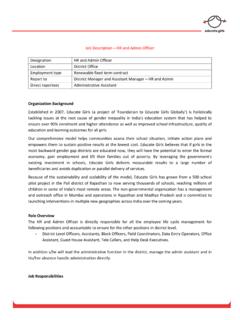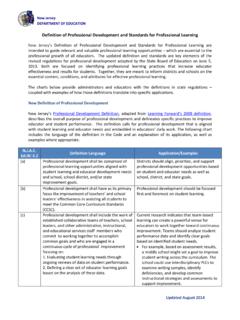Transcription of WHO (1988) The Challenge of Implementation: District ...
1 WHO (1988) The Challenge of Implementation: District HealthSystems for primary health care , Part A pp 7-11 and Part C pp65-67, GenevaWhat is this paper about?This paper is concerned with the promotion of District health systems based on primary health care . Itreviews some of the key problems confronting the District . and describes the innovative and promisingstrategies that have been developed in a number of countries to address these problems. Its basicpremise is that, to implement the visions of Alma Ata. we need to re-orient, re-organize and strengthendistrict health health systems are not a new idea. Decentralization and central control have long beenimportant political and organizational issues and strategies.
2 Management of health services for definedgeographical areas from regional. provincial or District centres has been a common feature of mosthealth systems in developing and developed countries alike. What we are advocating here and now isa renewed effort to implement primary health care and to strengthen the intermediate level in order tosupport and invigorate this effort. To succeed, primary health care must have as its cornerstone a clearand firm national policy, and unwavering support from the top. But its full realization depends criticallyon the people in the District who are charged with the management and implementation of PHCstrategies. It is in the District where top down and bottom up meet.
3 If they are to meet at District provides an excellent organizational framework within which to introduce changes in thehealth system. At this level. policies. plans and practical realities can meet, and feasible solutions canbe developed. provided that human and material resources are made available and sufficient authorityis this document, we address members of national authorities concerned with health systemsmanagement and delivery; people responsible for other sectors that are important for health , such asagriculture, education, environment and planning; regional and District health managers; donoragencies; and colleagues within WHO and other international hope that the paper will0 inspire supportive action for strengthening districts from national and regional levels:0 promote efforts to improve performance at the District level.
4 0 guide strategy development and implementation planning:0 stimulate an increase in bilateral and multilateral funding for District development: and0 demonstrate WHO's interest and willingness to assist and support these is the paper organized?This document builds on the background paper and on the report of the Inter-Regional Meeting onStrengthening District health Systems based on primary health care held in Harare in August 1987. InPart A. we first present a description of the District health system and its major elements. This is followedby a brief discussion of the essential preconditions that need to be in place for effective District healthsystems to develop and B contains five chapters, one on each of the major elements of the District health system.
5 We havecalled these major elements 'pillars', emphasizing their interdependent role as building blocks andstructural support. They cover organization. planning and management; resource allocation andfinancing; intersectoral action; community involvement; and development of human country experiences presented in these five chapters are an integral part of the text and form thecore of the paper. Each of these chapters is organized according to a common format: Following a briefdescription of the pillar under review. some key problems are identified. We then explore issues arisingfrom these problems and review the developments made in a number of countries in response to theseissues.
6 Specific attention is given to the practical steps that can be and have been taken so that othersmay learn, and adopt and adapt these strategies to their own circumstances. Each chapter ends with aset of conclusions about the problems and experiences Part C. we draw together the conclusions and propose directions towards the formulation of aframework for action to guide both planners and implementers. The paper concludes by identifying a setof critical considerations that need to be addressed in the development. Implementation and evaluationof any strategies adopted for strengthening District health systems based on primary health 'What are the limitations of the paper?The pillars of the District health system described here have been identified over a long period of WHOinvolvement in many countries.
7 They were used during the Inter-Regional Meeting on StrengtheningDistrict health Systems in Harare in 1987. where they served as a useful framework for presentingissues and experiences. We have decided to maintain the same framework in this paper. although otherclassifications are. of course. have not reviewed total country experiences of primary health care development nor are weproviding an historical analysis of the development of entire District health systems. Our approach hasbeen to highlight specific aspects of District development rather than produce comprehensive is a District health system?The following definition of the District health system was adopted by the WHO Global ProgrammeCommittee in 1986:'A District health system based on primary health care is a more or less self-contained segment ofthe national health system.
8 It comprises first and foremost a well-defined population, living within aclearly delineated administrative and geographical area, whether urban or rural. It includes allinstitutions and individuals providing health care in the District , whether governmental, socialsecurity, non-governmental, private, or traditional. A District health system, therefore, consists of alarge variety of interrelated elements that contribute to health in homes, schools, work places, andcommunities, through the health and other related sectors. It includes self- care and all health careworkers and facilities, up to and including the hospital at the first referral level and the appropriatelaboratory, other diagnostic, and logistic support services.
9 Its component elements need to be wellcoordinated by an officer assigned to this function in order to draw together all these elements andinstitutions into a fully comprehensive range of promotive, preventive, curative and rehabilitativehealth activities.'Throughout this document, the term District is used in a generic sense to denote a clearly definedadministrative area, which commonly has a population of betweeen 50,000 and where someform of local government or administration takes over many of the responsibilities from centralgovernment sectors or departments, and where a general hospital for referral support exists. The actualorganization of District health systems obviously depends on the specific situation in each country andeach District , including the administrative structure and personalities involved.
10 Nevertheless, thegeneral principles for developing such systems are based on the Declaration of Alma Ata and the GlobalStrategy for health For All, and incorporate the following:0 equity0 accessibility0 emphasis on promotion and prevention0 intersectoral action0 community involvement0 decentralization0 integration of health programmes0 coordination of separate health focus on the District ?Ten years ago, the call for ' health for All by the Year 2000' led to massive political commitment aroundthe world to the primary health care approach. National primary health care plans were many countries, the development of a cadre of community health workers, often volunteers, becamethe key strategy for involving the communities in improving the health of their people.









